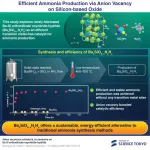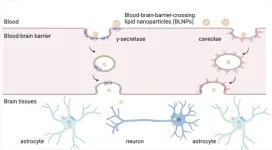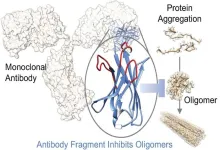(Press-News.org)
As the world moves toward sustainability, the demand for efficient alternatives across industries continues to grow. Ammonia, a key chemical used in fertilizers, explosives, and various other products, is primarily synthesized through the energy-intensive Haber-Bosch process. This process requires extremely high temperatures and pressures, contributing to global carbon dioxide emissions. Conventional catalysts, such as iron and ruthenium, rely on these harsh conditions to drive the reaction. However, a recent study by researchers from Institute of Science Tokyo, the National Institute for Materials Science, and Tohoku University, Japan, led by Professor Masaaki Kitano, explores Ba3SiO5−xNyHz catalyst as a sustainable alternative to traditional catalysts, potentially revolutionizing ammonia synthesis.
Vacancies, especially anion vacancies within the three-dimensional structure of catalysts, function as active sites. These active sites are energetically involved in the process of catalysis. However, anion vacancies alone are not effective without the presence of transition metal sites. This limitation inspired researchers to develop a transition metal-free catalyst.
Published online in Nature Chemistry on 17 February 2025, the study aims to develop more efficient, sustainable ammonia synthesis methods. Kitano explains, "We have focused on tribarium silicate (Ba3SiO5) for the synthesis of our novel catalyst due to its unique crystal structure and chemical properties, offering the potential to lower energy requirements and reduce operating conditions," describing the initial step in their research. To address the environmental and energy challenges posed by conventional synthesis methods, the research team developed and tested various mixed-anion materials.
The study progressed through several stages. First, the researchers synthesized a novel Ba-Si oxynitride-hydride, Ba3SiO5−xNyHz, through a low-temperature (400–700 °C) solid-state reaction of barium amide with silicon dioxide. The resulting chemical composition was determined to be Ba3SiO2.87N0.80H1.86. This synthesis temperature is much lower than the synthesis temperatures (1100–1400 °C) of conventional silicate materials such as Ba3SiO5, Ba₃Si₆O₉N₄, and BaSi₂O₂N₂. The synthesized Ba3SiO5−xNyHz demonstrated exceptional stability as a catalyst for ammonia synthesis even in the absence of any transition metal sites. It showed higher activity and lower activation energy than the conventional ruthenium-loaded MgO catalyst. On the other hand, Ba3SiO5, Ba₃Si₆O₉N₄, and BaSi₂O₂N₂ exhibited no catalytic activity. The Ba3SiO5−xNyHz catalyst’s ammonia synthesis activity was tested under varying temperatures and pressures, and structural properties were analyzed using advanced instrumentation techniques.
To further improve performance, ruthenium nanoparticles were introduced. The researchers found that Ba3SiO5−xNyHz showed the highest catalytic activity with ruthenium nanoparticles. "The addition of ruthenium nanoparticles significantly boosted catalytic performance, enabling more efficient ammonia synthesis under milder conditions. However, the main active site is not ruthenium nanoparticles but the anion vacancy sites on Ba3SiO5−xNyHz, which reduces the apparent energy requirement for ammonia synthesis than conventional catalysts. We also discovered that the anion vacancy-mediated mechanism played a key role in facilitating nitrogen activation, without relying on transition metals," says Kitano. These findings suggest a more sustainable and energy-efficient path for ammonia synthesis.
The study highlights key benefits: reduced temperature and pressure enhance efficiency, while the transition metal-free pathway cuts emissions and resource dependence, supporting sustainability. Furthermore, the scalable synthesis and robust performance of Ba3SiO5−xNyHz catalysts position them as promising candidates for industrial adoption, offering a more sustainable approach to ammonia production at scale. These findings also open avenues for further research in transition metal-free catalysis for other critical processes.
This study represents a significant step toward sustainable ammonia synthesis, addressing a major challenge in industrial chemistry. By demonstrating the potential of the Ba3SiO5−xNyHz catalyst, the researchers have laid the foundation for a greener and more efficient approach to producing ammonia, an essential chemical. As the global demand for ammonia continues to rise, innovations like this will be instrumental in driving a more sustainable future.
##
About Institute of Science Tokyo (Science Tokyo)
Institute of Science Tokyo (Science Tokyo) was established on October 1, 2024, following the merger between Tokyo Medical and Dental University (TMDU) and Tokyo Institute of Technology (Tokyo Tech), with the mission of “Advancing science and human wellbeing to create value for and with society.”
https://www.isct.ac.jp/en
END
Thousands of single changes in the nucleotides that make up the human genome have been associated with an increased risk of developing cancer. But until now, it’s not been clear which are directly responsible for the uncontrolled cellular growth that is the hallmark of the disease and which are simply coincidences or minor players.
Stanford researchers have conducted the first large-scale screen of these inherited changes, called single nucleotide variants, and homed in on fewer than 400 that are essential to initiate and drive cancer growth. These variants control several common biological ...
New York, NY [February 17, 2025]—Scientists at the Icahn School of Medicine at Mount Sinai have developed a lipid nanoparticle system capable of delivering messenger RNA (mRNA) to the brain via intravenous injection, a challenge that has long been limited by the protective nature of the blood-brain barrier.
The findings, in mouse models and isolated human brain tissue, were published in the February 17 online issue of Nature Materials [10.1038/s41563-024-02114-5]. They demonstrate the potential of this technology to pave the way for ...
In September 2018, a wildfire burned nearly two thousand hectares of shrubland on the Pichu Pichu volcano, an ecologically significant area in the Peruvian Andes. Unlike Mediterranean ecosystems, where vegetation has evolved strategies to withstand fire, the volcanic soils of Arequipa—one of the driest regions in the world—are not adapted to wildfire disturbances. A Miguel Hernández University of Elche (UMH) research team collected and analyzed soil samples from the burned area at 3,700 meters above sea level to understand how these fragile ecosystems ...
These include those linked to body image, fatherhood and sexual relationships. His latest book - Current Issues Facing Men and Boys – also argues that men struggle to negotiate harmful notions of masculinity and are not included in conversations around gender.
Current Issues Facing Men and Boys urges the public, policymakers, practitioners and other key stakeholders to explore and support policies and practices that promote male wellbeing. This book comes as the UK government announces plans for the country's first men's health strategy, aiming ...
For teens who may be self-conscious about issues such as acne scarring or discolored teeth, non-surgical cosmetic procedures are an increasingly popular way to address their concerns.
And some parents are supportive of this decision, a national poll suggests, with a sixth saying teenagers should be allowed to receive these types of aesthetic treatments for any reason as long as they have parental approval.
But half of parents only support teens getting non-surgical cosmetic procedures if there’s a valid reason – and their beliefs about which reasons count as valid differ – according to ...
This September, recipients of the Abel Prize, ACM A.M. Turing Award, ACM Prize in Computing, Fields Medal, IMU Abacus Medal and the Nevanlinna Prize are invited to gather in Heidelberg to meet with 200 young researchers from all over the world at the 12th Heidelberg Laureate Forum (HLF). In order to reach a broader, more diverse and international audience, the Heidelberg Laureate Forum Foundation (HLFF) encourages journalists to cover the event and affords them the chance to interact with the preeminent scientists of mathematics and computer science. The 12th HLF will take ...
The evolutionary roots of human dominance and aggression remain central to social and political behaviour, and without conscious intervention these primal survival drives will continue to fuel inequality and division.
These are the arguments of a medical professor who, as global conflicts rise and democracies face growing challenges, says understanding how dominance and tribal instincts fuel division is more critical than ever.
In A New Approach to Human Social Evolution, Professor Jorge A. Colombo MD, PhD explores neuroscience, anthropology, and behavioural science to provide a new perspective on human social evolution.
He argues that fundamental behavioural drives ...
A rare discovery of a nearly complete skull in the Egyptian desert has led scientists to the “dream” revelation of a new 30-million-year-old species of the ancient apex predatory carnivore, Hyaenodonta.
Bearing sharp teeth and powerful jaw muscles, suggesting a strong bite, the newly-identified ‘Bastetodon’ was a leopard-sized “fearsome” mammal. It would have been at the top of all carnivores and the food chain when our own monkey-like ancestors were evolving.
Findings, published in the peer-reviewed Journal of Vertebrate Paleontology, detail ...
University of Leeds news
Embargoed until 05:01 GMT, 17 February
Reintroducing wolves to the Scottish Highlands could lead to an expansion of native woodland which could take in and store one million tonnes of CO2 annually, according to a new study led by researchers at the University of Leeds.
The team modelled the potential impact that wolves could have in four areas classified as Scottish Wild Land, where the eating of tree saplings by growing red deer populations is suppressing natural regeneration of trees and woodland.
They used a predator–prey model to ...
ROCKVILLE, MD – In diseases like Parkinson's and Alzheimer's, specific proteins misfold and clump together, forming toxic aggregates that damage brain cells. The process of proteins spontaneously clumping is called protein aggregation and researchers have developed novel methods to generate aggregate-specific antibodies as specific probes or modulators of the aggregation process.
This new method overcomes significant challenges in characterizing these complex and often transient protein structures. The work will be presented at the 69th Biophysical ...








